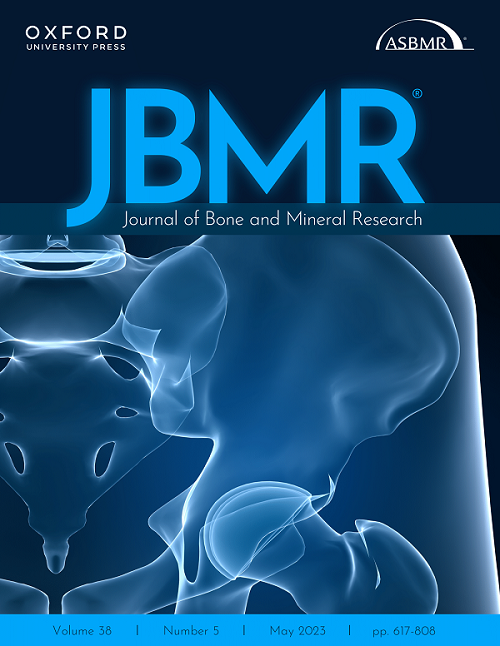Rare and Common Variants in GALNT3 May Affect Bone Mass Independently of Phosphate Metabolism
IF 5.1
1区 医学
Q1 ENDOCRINOLOGY & METABOLISM
Neelam Hassan, Celia L. Gregson, Haotian Tang, Marc van der Kamp, Paul Leo, Aideen M. McInerney-Leo, Jie Zheng, Maria Luisa Brandi, Jonathan C. Y. Tang, William Fraser, Michael D. Stone, Elin Grundberg, Anglo-Australasian Genetics Consortium, Matthew A. Brown, Emma L. Duncan, Jonathan H. Tobias
下载PDF
{"title":"Rare and Common Variants in GALNT3 May Affect Bone Mass Independently of Phosphate Metabolism","authors":"Neelam Hassan, Celia L. Gregson, Haotian Tang, Marc van der Kamp, Paul Leo, Aideen M. McInerney-Leo, Jie Zheng, Maria Luisa Brandi, Jonathan C. Y. Tang, William Fraser, Michael D. Stone, Elin Grundberg, Anglo-Australasian Genetics Consortium, Matthew A. Brown, Emma L. Duncan, Jonathan H. Tobias","doi":"10.1002/jbmr.4795","DOIUrl":null,"url":null,"abstract":"<p>Anabolic treatment options for osteoporosis remain limited. One approach to discovering novel anabolic drug targets is to identify genetic causes of extreme high bone mass (HBM). We investigated a pedigree with unexplained HBM within the UK HBM study, a national cohort of probands with HBM and their relatives. Whole exome sequencing (WES) in a family with HBM identified a rare heterozygous missense variant (NM_004482.4:c.1657C > T, p.Arg553Trp) in <i>GALNT3</i>, segregating appropriately. Interrogation of data from the UK HBM study and the Anglo-Australasian Osteoporosis Genetics Consortium (AOGC) revealed an unrelated individual with HBM with another rare heterozygous variant (NM_004482.4:c.831 T > A, p.Asp277Glu) within the same gene. In silico protein modeling predicted that p.Arg553Trp would disrupt salt-bridge interactions, causing instability of GALNT3, and that p.Asp277Glu would disrupt manganese binding and consequently GALNT3 catalytic function. Bi-allelic loss-of-function <i>GALNT3</i> mutations alter FGF23 metabolism, resulting in hyperphosphatemia and causing familial tumoral calcinosis (FTC). However, bone mineral density (BMD) in FTC cases, when reported, has been either normal or low. Common variants in the <i>GALNT3</i> locus show genome-wide significant associations with lumbar, femoral neck, and total body BMD. However, no significant associations with BMD are observed at loci coding for FGF23, its receptor FGFR1, or coreceptor klotho. Mendelian randomization analysis, using expression quantitative trait loci (eQTL) data from primary human osteoblasts and genome-wide association studies data from UK Biobank, suggested increased expression of <i>GALNT3</i> reduces total body, lumbar spine, and femoral neck BMD but has no effect on phosphate concentrations. In conclusion, rare heterozygous loss-of-function variants in <i>GALNT3</i> may cause HBM without altering phosphate concentration. These findings suggest that GALNT3 may affect BMD through pathways other than FGF23 regulation, the identification of which may yield novel anabolic drug targets for osteoporosis. © 2023 The Authors. <i>Journal of Bone and Mineral Research</i> published by Wiley Periodicals LLC on behalf of American Society for Bone and Mineral Research (ASBMR).</p>","PeriodicalId":185,"journal":{"name":"Journal of Bone and Mineral Research","volume":"38 5","pages":"678-691"},"PeriodicalIF":5.1000,"publicationDate":"2023-02-23","publicationTypes":"Journal Article","fieldsOfStudy":null,"isOpenAccess":false,"openAccessPdf":"https://onlinelibrary.wiley.com/doi/epdf/10.1002/jbmr.4795","citationCount":"0","resultStr":null,"platform":"Semanticscholar","paperid":null,"PeriodicalName":"Journal of Bone and Mineral Research","FirstCategoryId":"3","ListUrlMain":"https://onlinelibrary.wiley.com/doi/10.1002/jbmr.4795","RegionNum":1,"RegionCategory":"医学","ArticlePicture":[],"TitleCN":null,"AbstractTextCN":null,"PMCID":null,"EPubDate":"","PubModel":"","JCR":"Q1","JCRName":"ENDOCRINOLOGY & METABOLISM","Score":null,"Total":0}
引用次数: 0
引用
批量引用
Abstract
Anabolic treatment options for osteoporosis remain limited. One approach to discovering novel anabolic drug targets is to identify genetic causes of extreme high bone mass (HBM). We investigated a pedigree with unexplained HBM within the UK HBM study, a national cohort of probands with HBM and their relatives. Whole exome sequencing (WES) in a family with HBM identified a rare heterozygous missense variant (NM_004482.4:c.1657C > T, p.Arg553Trp) in GALNT3 , segregating appropriately. Interrogation of data from the UK HBM study and the Anglo-Australasian Osteoporosis Genetics Consortium (AOGC) revealed an unrelated individual with HBM with another rare heterozygous variant (NM_004482.4:c.831 T > A, p.Asp277Glu) within the same gene. In silico protein modeling predicted that p.Arg553Trp would disrupt salt-bridge interactions, causing instability of GALNT3, and that p.Asp277Glu would disrupt manganese binding and consequently GALNT3 catalytic function. Bi-allelic loss-of-function GALNT3 mutations alter FGF23 metabolism, resulting in hyperphosphatemia and causing familial tumoral calcinosis (FTC). However, bone mineral density (BMD) in FTC cases, when reported, has been either normal or low. Common variants in the GALNT3 locus show genome-wide significant associations with lumbar, femoral neck, and total body BMD. However, no significant associations with BMD are observed at loci coding for FGF23, its receptor FGFR1, or coreceptor klotho. Mendelian randomization analysis, using expression quantitative trait loci (eQTL) data from primary human osteoblasts and genome-wide association studies data from UK Biobank, suggested increased expression of GALNT3 reduces total body, lumbar spine, and femoral neck BMD but has no effect on phosphate concentrations. In conclusion, rare heterozygous loss-of-function variants in GALNT3 may cause HBM without altering phosphate concentration. These findings suggest that GALNT3 may affect BMD through pathways other than FGF23 regulation, the identification of which may yield novel anabolic drug targets for osteoporosis. © 2023 The Authors. Journal of Bone and Mineral Research published by Wiley Periodicals LLC on behalf of American Society for Bone and Mineral Research (ASBMR).
罕见和常见的GALNT3变异可能独立于磷酸盐代谢影响骨量
骨质疏松症的合成代谢治疗选择仍然有限。发现新的合成代谢药物靶点的一种方法是确定极高骨量(HBM)的遗传原因。我们在英国HBM研究中调查了一个不明原因HBM的家系,这是一个全国性的HBM先证者及其亲属队列。HBM家族的全外显子组测序(WES)在GALNT3中发现了一个罕见的杂合错义变异(NM_004482.4:c.1657C > T, p.Arg553Trp),分离适当。对英国HBM研究和英澳骨质疏松症遗传联盟(AOGC)数据的分析显示,HBM患者在同一基因内具有另一种罕见的杂合变异(NM_004482.4:c.831 T > A, p.Asp277Glu)。硅蛋白模型预测p.Arg553Trp会破坏盐桥相互作用,导致GALNT3不稳定,p.Asp277Glu会破坏锰结合,从而破坏GALNT3的催化功能。双等位基因GALNT3功能丧失突变改变FGF23代谢,导致高磷血症并引起家族性肿瘤钙沉着症(FTC)。然而,在报告的FTC病例中,骨密度(BMD)要么正常,要么低。GALNT3基因座的常见变异在全基因组范围内与腰椎、股骨颈和全身骨密度显著相关。然而,在编码FGF23、其受体FGFR1或辅助受体klotho的位点上,未观察到与BMD的显著关联。孟德尔随机化分析,使用来自原代人成骨细胞的表达数量性状位点(eQTL)数据和来自UK Biobank的全基因组关联研究数据,表明GALNT3的表达增加会降低全身、腰椎和股骨颈的骨密度,但对磷酸盐浓度没有影响。总之,GALNT3中罕见的杂合功能缺失变异可能在不改变磷酸盐浓度的情况下引起HBM。这些发现表明GALNT3可能通过FGF23调节以外的途径影响BMD,鉴定其可能产生新的骨质疏松症合成代谢药物靶点。©2023作者。由Wiley期刊有限责任公司代表美国骨与矿物研究协会(ASBMR)出版的骨与矿物研究杂志。
本文章由计算机程序翻译,如有差异,请以英文原文为准。
来源期刊
期刊介绍:
The Journal of Bone and Mineral Research (JBMR) publishes highly impactful original manuscripts, reviews, and special articles on basic, translational and clinical investigations relevant to the musculoskeletal system and mineral metabolism. Specifically, the journal is interested in original research on the biology and physiology of skeletal tissues, interdisciplinary research spanning the musculoskeletal and other systems, including but not limited to immunology, hematology, energy metabolism, cancer biology, and neurology, and systems biology topics using large scale “-omics” approaches. The journal welcomes clinical research on the pathophysiology, treatment and prevention of osteoporosis and fractures, as well as sarcopenia, disorders of bone and mineral metabolism, and rare or genetically determined bone diseases.

 求助内容:
求助内容: 应助结果提醒方式:
应助结果提醒方式:


